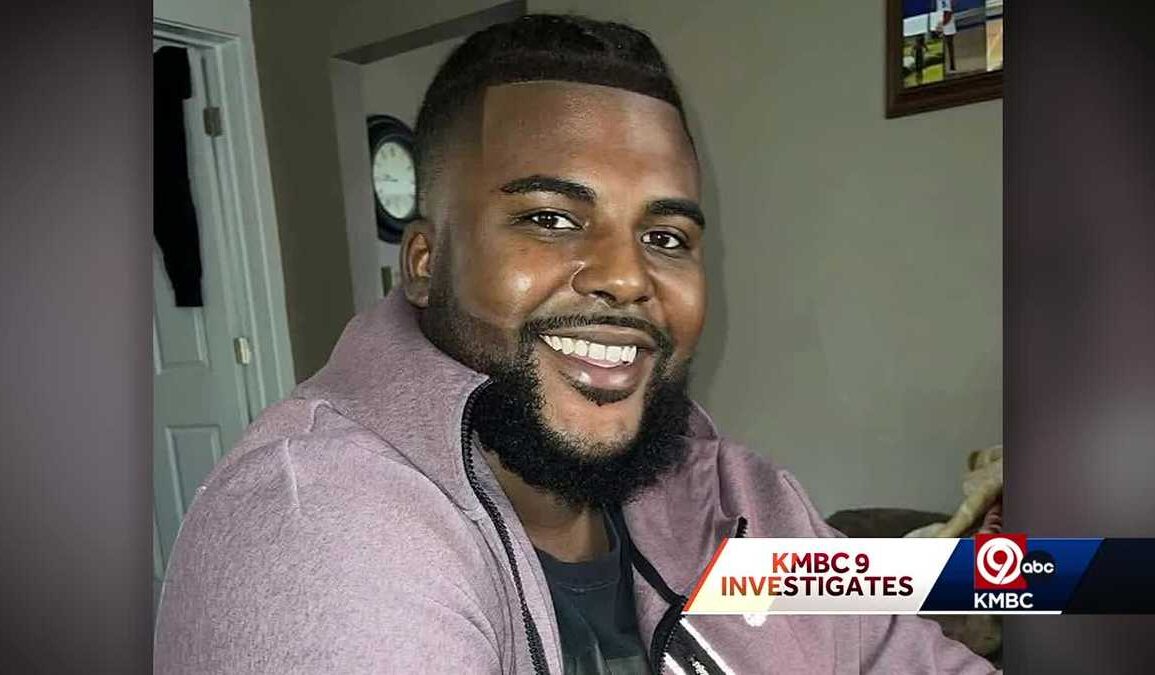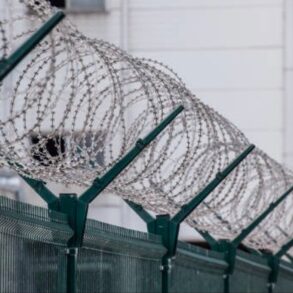
A family is demanding murder charges for corrections workers involved in the death of a 25-year-old man after his time in a Montgomery County, Ohio, jail restraint chair.Family and attorneys for Christian Black, 25, believe a technique used by jailers to apply force to his back while in a restraint chair was a significant factor in his death.Black’s case mirrors the deaths of two other men identified in a nationwide KMBC 9 News investigation into the use of restraint chairs or full-body restraint systems in U.S. jails and prisons. In each case, jailers strapped the man’s legs and lap into a restraint chair, then held his face toward his knees by pressing on his back for an extended time to remove handcuffs.Each man became unresponsive after spending extended time in the restraint chair. All later died.“I think that’s what took my son’s life, ultimately — the suffocation from being bent over and having pressure applied to his torso,” Christian’s father, Kenya Black, told KMBC 9 Investigates.Black’s case brings up fresh questions if law enforcement needs to update their training and use of restraint chairs. These chairs are intended to keep inmates and staff safe during severe mental or behavioral episodes. But a nationwide investigation by KMBC 9 News found more than 100 injuries or deaths linked to such devices over the past decade. Taxpayers have paid nearly $100 million in settlements and judgments in those cases.Video released in Christian Black’s restraint chair deathVideo released by Black’s family attorneys on Monday show officers struggle with Black as they removed him from a holding cell in the jail’s mental health area after he banged his head and body against the door multiple times on March 24, 2025.They tased and pepper sprayed Black in the cell, according to the attorneys, then handcuffed him on the floor.Officers put him in a restraint chair then put a spit mask over his head.Video also shows officers pressed his back toward his knees for more than two minutes.The video shows multiple officers with their hands pressed against Black’s back as they removed handcuffs. When they returned him to an upright position, he appears to not respond.He died two days after he went unresponsive in the Montgomery County jail.The Montgomery County Coroner has preliminarily listed his cause of death as positional and mechanical asphyxia.“He was put in a position where he couldn’t breathe for a period of time that caused him to die,” said Michael Wright, an attorney for the Black family, during a Monday news conference.The Dayton Police Department is now investigating whether officers could face criminal charges.The Montgomery County Sheriff’s Office issued a statement last week promising a thorough internal review and investigation to ensure transparency and accountability. A spokesperson said the department has not made any changes to restraint chair policies or procedures since Black’s death. She was checking on a question from KMBC 9 Investigates about the technique of pressing an inmate’s torso forward while removing handcuffs.Meanwhile, Black’s family is calling for the sheriff to resign and for officers involved to be charged with murder.The family’s investigation into the circumstances surrounding Black’s death continues as they plan for a lawsuit.“I believe that the technique of pushing individuals down in the fashion in which they push Christian is something that should be certainly avoided,” said Black’s family attorney Robert Gresham, of Wright and Schulte.Technique mirrors two other deaths uncovered by KMBC 9 InvestigatesChristian Black’s case is strikingly similar to restraint chair incidents in two other cases identified by KMBC 9 Investigates.Nicholas Farah died in Las Vegas in 2019 after officers pushed his head down for nearly a minute and a half while he was in a restraint chair. Farah’s family received a $2.38 million settlement.Malcolm James died in Wisconsin in 2021 after six officers held him down and pushed his head forward toward his knees in a restraint chair. Those officers did not face charges.Leaning someone forward in a jail restraint chair for an extended time to remove handcuffs with force applied to their back is a technique law enforcement experts believe could lead to compromised breathing.“So what if he’s handcuffed? He’s in the restraint chair.” said Dr. John G. Peters Jr., President and Chief Learning Officer of Institute for the Prevention of In-Custody Deaths, Inc. Peters reviewed video of James’ case and believed officers could have acted much sooner to provide care.“For practical purposes, although there are exceptions, he’s not going anywhere.”Peters said often jail staff use restraint chairs without proper training. He works to ensure law enforcement agencies make competency a key component of training before anyone uses a restraint chair inside a jail.KMBC chronicle explores families’ stories, solutions to restraint chair risksFamilies, law enforcement leaders, manufacturers and state officials are sharing their experiences with restraint systems in KMBC 9 Chronicle: Restrained. The report reveals never-before-seen footage, firsthand accounts and proposals to help prevent more deaths in jails and prisons.KMBC plans to share its findings with lawmakers, law enforcement and policymakers to help improve safety for both inmates and staff.To watch the full KMBC 9 Chronicle, click here. If you have a story to share about restraint chair use inside a jail or prison, email investigates@kmbc.com.
A family is demanding murder charges for corrections workers involved in the death of a 25-year-old man after his time in a Montgomery County, Ohio, jail restraint chair.
Family and attorneys for Christian Black, 25, believe a technique used by jailers to apply force to his back while in a restraint chair was a significant factor in his death.
Advertisement
Black’s case mirrors the deaths of two other men identified in a nationwide KMBC 9 News investigation into the use of restraint chairs or full-body restraint systems in U.S. jails and prisons.
In each case, jailers strapped the man’s legs and lap into a restraint chair, then held his face toward his knees by pressing on his back for an extended time to remove handcuffs.
Each man became unresponsive after spending extended time in the restraint chair.
All later died.
“I think that’s what took my son’s life, ultimately — the suffocation from being bent over and having pressure applied to his torso,” Christian’s father, Kenya Black, told KMBC 9 Investigates.
Black’s case brings up fresh questions if law enforcement needs to update their training and use of restraint chairs.
These chairs are intended to keep inmates and staff safe during severe mental or behavioral episodes.
But a nationwide investigation by KMBC 9 News found more than 100 injuries or deaths linked to such devices over the past decade.
Taxpayers have paid nearly $100 million in settlements and judgments in those cases.
Video released in Christian Black’s restraint chair death
Video released by Black’s family attorneys on Monday show officers struggle with Black as they removed him from a holding cell in the jail’s mental health area after he banged his head and body against the door multiple times on March 24, 2025.
They tased and pepper sprayed Black in the cell, according to the attorneys, then handcuffed him on the floor.
Officers put him in a restraint chair then put a spit mask over his head.
Video also shows officers pressed his back toward his knees for more than two minutes.
The video shows multiple officers with their hands pressed against Black’s back as they removed handcuffs. When they returned him to an upright position, he appears to not respond.
He died two days after he went unresponsive in the Montgomery County jail.
The Montgomery County Coroner has preliminarily listed his cause of death as positional and mechanical asphyxia.
“He was put in a position where he couldn’t breathe for a period of time that caused him to die,” said Michael Wright, an attorney for the Black family, during a Monday news conference.
The Dayton Police Department is now investigating whether officers could face criminal charges.
The Montgomery County Sheriff’s Office issued a statement last week promising a thorough internal review and investigation to ensure transparency and accountability.
A spokesperson said the department has not made any changes to restraint chair policies or procedures since Black’s death.
She was checking on a question from KMBC 9 Investigates about the technique of pressing an inmate’s torso forward while removing handcuffs.
Meanwhile, Black’s family is calling for the sheriff to resign and for officers involved to be charged with murder.
The family’s investigation into the circumstances surrounding Black’s death continues as they plan for a lawsuit.
“I believe that the technique of pushing individuals down in the fashion in which they push Christian is something that should be certainly avoided,” said Black’s family attorney Robert Gresham, of Wright and Schulte.
Technique mirrors two other deaths uncovered by KMBC 9 Investigates
Christian Black’s case is strikingly similar to restraint chair incidents in two other cases identified by KMBC 9 Investigates.
Nicholas Farah died in Las Vegas in 2019 after officers pushed his head down for nearly a minute and a half while he was in a restraint chair.
Farah’s family received a $2.38 million settlement.
Malcolm James died in Wisconsin in 2021 after six officers held him down and pushed his head forward toward his knees in a restraint chair.
Those officers did not face charges.
Leaning someone forward in a jail restraint chair for an extended time to remove handcuffs with force applied to their back is a technique law enforcement experts believe could lead to compromised breathing.
“So what if he’s handcuffed? He’s in the restraint chair.” said Dr. John G. Peters Jr., President and Chief Learning Officer of Institute for the Prevention of In-Custody Deaths, Inc.
Peters reviewed video of James’ case and believed officers could have acted much sooner to provide care.
“For practical purposes, although there are exceptions, he’s not going anywhere.”
Peters said often jail staff use restraint chairs without proper training.
He works to ensure law enforcement agencies make competency a key component of training before anyone uses a restraint chair inside a jail.
KMBC chronicle explores families’ stories, solutions to restraint chair risks
Families, law enforcement leaders, manufacturers and state officials are sharing their experiences with restraint systems in KMBC 9 Chronicle: Restrained.
The report reveals never-before-seen footage, firsthand accounts and proposals to help prevent more deaths in jails and prisons.
KMBC plans to share its findings with lawmakers, law enforcement and policymakers to help improve safety for both inmates and staff.
To watch the full KMBC 9 Chronicle, click here.
If you have a story to share about restraint chair use inside a jail or prison, email investigates@kmbc.com.
This post was originally published on this site be sure to check out more of their content.









